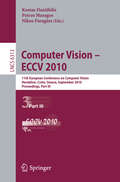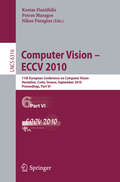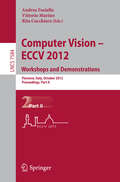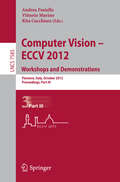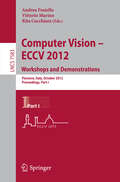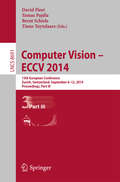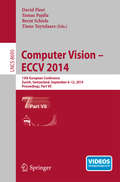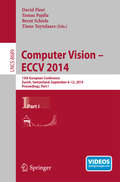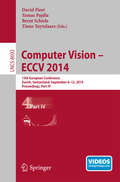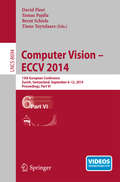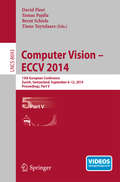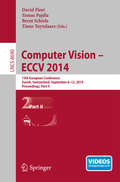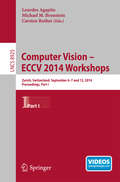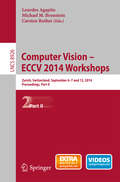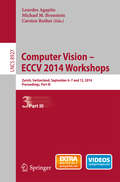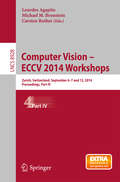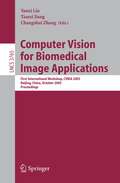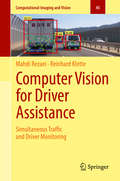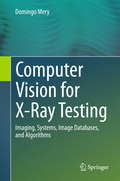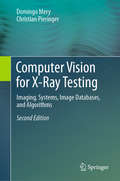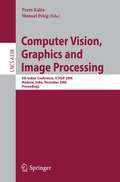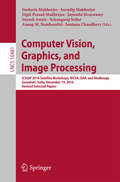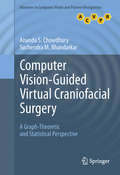- Table View
- List View
Computer Vision -- ECCV 2010: 11th European Conference on Computer Vision, Heraklion, Crete, Greece, September 5-11, 2010, Proceedings, Part III (Lecture Notes in Computer Science #6313)
by Kostas Daniilidis Petros Maragos Nikos ParagiosThe 2010 edition of the European Conference on Computer Vision was held in Heraklion, Crete. The call for papers attracted an absolute record of 1,174 submissions. We describe here the selection of the accepted papers: Thirty-eight area chairs were selected coming from Europe (18), USA and Canada (16), and Asia (4). Their selection was based on the following criteria: (1) Researchers who had served at least two times as Area Chairs within the past two years at major vision conferences were excluded; (2) Researchers who served as Area Chairs at the 2010 Computer Vision and Pattern Recognition were also excluded (exception: ECCV 2012 Program Chairs); (3) Minimization of overlap introduced by Area Chairs being former student and advisors; (4) 20% of the Area Chairs had never served before in a major conference; (5) The Area Chair selection process made all possible efforts to achieve a reasonable geographic distribution between countries, thematic areas and trends in computer vision. Each Area Chair was assigned by the Program Chairs between 28–32 papers. Based on paper content, the Area Chair recommended up to seven potential reviewers per paper. Such assignment was made using all reviewers in the database including the conflicting ones. The Program Chairs manually entered the missing conflict domains of approximately 300 reviewers. Based on the recommendation of the Area Chairs, three reviewers were selected per paper (with at least one being of the top three suggestions), with 99.
Computer Vision -- ECCV 2010: 11th European Conference on Computer Vision, Heraklion, Crete, Greece, September 5-11, 2010, Proceedings, Part VI (Lecture Notes in Computer Science #6316)
by Kostas Daniilidis Petros Maragos Nikos ParagiosThe 2010 edition of the European Conference on Computer Vision was held in Heraklion, Crete. The call for papers attracted an absolute record of 1,174 submissions. We describe here the selection of the accepted papers: Thirty-eight area chairs were selected coming from Europe (18), USA and Canada (16), and Asia (4). Their selection was based on the following criteria: (1) Researchers who had served at least two times as Area Chairs within the past two years at major vision conferences were excluded; (2) Researchers who served as Area Chairs at the 2010 Computer Vision and Pattern Recognition were also excluded (exception: ECCV 2012 Program Chairs); (3) Minimization of overlap introduced by Area Chairs being former student and advisors; (4) 20% of the Area Chairs had never served before in a major conference; (5) The Area Chair selection process made all possible efforts to achieve a reasonable geographic distribution between countries, thematic areas and trends in computer vision. Each Area Chair was assigned by the Program Chairs between 28–32 papers. Based on paper content, the Area Chair recommended up to seven potential reviewers per paper. Such assignment was made using all reviewers in the database including the conflicting ones. The Program Chairs manually entered the missing conflict domains of approximately 300 reviewers. Based on the recommendation of the Area Chairs, three reviewers were selected per paper (with at least one being of the top three suggestions), with 99.
Computer Vision -- ECCV 2012. Workshops and Demonstrations: Florence, Italy, October 7-13, 2012, Proceedings, Part II (Lecture Notes in Computer Science #7584)
by Andrea Fusiello Vittorio Murino Rita CucchiaraThe three volume set LNCS 7583, 7584 and 7585 comprises the Workshops and Demonstrations which took place in connection with the European Conference on Computer Vision, ECCV 2012, held in Firenze, Italy, in October 2012. The total of 179 workshop papers and 23 demonstration papers was carefully reviewed and selected for inclusion in the proceedings. They where held at workshops with the following themes: non-rigid shape analysis and deformable image alignment; visual analysis and geo-localization of large-scale imagery; Web-scale vision and social media; video event categorization, tagging and retrieval; re-identification; biological and computer vision interfaces; where computer vision meets art; consumer depth cameras for computer vision; unsolved problems in optical flow and stereo estimation; what's in a face?; color and photometry in computer vision; computer vision in vehicle technology: from earth to mars; parts and attributes; analysis and retrieval of tracked events and motion in imagery streams; action recognition and pose estimation in still images; higher-order models and global constraints in computer vision; information fusion in computer vision for concept recognition; 2.5D sensing technologies in motion: the quest for 3D; benchmarking facial image analysis technologies.
Computer Vision -- ECCV 2012. Workshops and Demonstrations: Florence, Italy, October 7-13, 2012, Proceedings, Part III (Lecture Notes in Computer Science #7585)
by Andrea Fusiello Vittorio Murino Rita CucchiaraThe three volume set LNCS 7583, 7584 and 7585 comprises the Workshops and Demonstrations which took place in connection with the European Conference on Computer Vision, ECCV 2012, held in Firenze, Italy, in October 2012. The total of 179 workshop papers and 23 demonstration papers was carefully reviewed and selected for inclusion in the proceedings. They where held at workshops with the following themes: non-rigid shape analysis and deformable image alignment; visual analysis and geo-localization of large-scale imagery; Web-scale vision and social media; video event categorization, tagging and retrieval; re-identification; biological and computer vision interfaces; where computer vision meets art; consumer depth cameras for computer vision; unsolved problems in optical flow and stereo estimation; what's in a face?; color and photometry in computer vision; computer vision in vehicle technology: from earth to mars; parts and attributes; analysis and retrieval of tracked events and motion in imagery streams; action recognition and pose estimation in still images; higher-order models and global constraints in computer vision; information fusion in computer vision for concept recognition; 2.5D sensing technologies in motion: the quest for 3D; benchmarking facial image analysis technologies.
Computer Vision -- ECCV 2012. Workshops and Demonstrations: Florence, Italy, October 7-13, 2012, Proceedings, Part I (Lecture Notes in Computer Science #7583)
by Andrea Fusiello Vittorio Murino Rita CucchiaraThe three volume set LNCS 7583, 7584 and 7585 comprises the Workshops and Demonstrations which took place in connection with the European Conference on Computer Vision, ECCV 2012, held in Firenze, Italy, in October 2012. The total of 179 workshop papers and 23 demonstration papers was carefully reviewed and selected for inclusion in the proceedings. They where held at workshops with the following themes: non-rigid shape analysis and deformable image alignment; visual analysis and geo-localization of large-scale imagery; Web-scale vision and social media; video event categorization, tagging and retrieval; re-identification; biological and computer vision interfaces; where computer vision meets art; consumer depth cameras for computer vision; unsolved problems in optical flow and stereo estimation; what's in a face?; color and photometry in computer vision; computer vision in vehicle technology: from earth to mars; parts and attributes; analysis and retrieval of tracked events and motion in imagery streams; action recognition and pose estimation in still images; higher-order models and global constraints in computer vision; information fusion in computer vision for concept recognition; 2.5D sensing technologies in motion: the quest for 3D; benchmarking facial image analysis technologies.
Computer Vision -- ECCV 2014: 13th European Conference, Zurich, Switzerland, September 6-12, 2014, Proceedings, Part III (Lecture Notes in Computer Science #8691)
by David Fleet Tomas Pajdla Bernt Schiele Tinne TuytelaarsThe seven-volume set comprising LNCS volumes 8689-8695 constitutes the refereed proceedings of the 13th European Conference on Computer Vision, ECCV 2014, held in Zurich, Switzerland, in September 2014.The 363 revised papers presented were carefully reviewed and selected from 1444 submissions. The papers are organized in topical sections on tracking and activity recognition; recognition; learning and inference; structure from motion and feature matching; computational photography and low-level vision; vision; segmentation and saliency; context and 3D scenes; motion and 3D scene analysis; and poster sessions.
Computer Vision -- ECCV 2014: 13th European Conference, Zurich, Switzerland, September 6-12, 2014, Proceedings, Part VII (Lecture Notes in Computer Science #8695)
by David Fleet Tomas Pajdla Bernt Schiele Tinne TuytelaarsThe seven-volume set comprising LNCS volumes 8689-8695 constitutes the refereed proceedings of the 13th European Conference on Computer Vision, ECCV 2014, held in Zurich, Switzerland, in September 2014. The 363 revised papers presented were carefully reviewed and selected from 1444 submissions. The papers are organized in topical sections on tracking and activity recognition; recognition; learning and inference; structure from motion and feature matching; computational photography and low-level vision; vision; segmentation and saliency; context and 3D scenes; motion and 3D scene analysis; and poster sessions.
Computer Vision -- ECCV 2014: 13th European Conference, Zurich, Switzerland, September 6-12, 2014, Proceedings, Part I (Lecture Notes in Computer Science #8689)
by David Fleet Tomas Pajdla Bernt Schiele Tinne TuytelaarsThe seven-volume set comprising LNCS volumes 8689-8695 constitutes the refereed proceedings of the 13th European Conference on Computer Vision, ECCV 2014, held in Zurich, Switzerland, in September 2014. The 363 revised papers presented were carefully reviewed and selected from 1444 submissions. The papers are organized in topical sections on tracking and activity recognition; recognition; learning and inference; structure from motion and feature matching; computational photography and low-level vision; vision; segmentation and saliency; context and 3D scenes; motion and 3D scene analysis; and poster sessions.
Computer Vision -- ECCV 2014: 13th European Conference, Zurich, Switzerland, September 6-12, 2014, Proceedings, Part IV (Lecture Notes in Computer Science #8692)
by David Fleet Tomas Pajdla Bernt Schiele Tinne TuytelaarsThe seven-volume set comprising LNCS volumes 8689-8695 constitutes the refereed proceedings of the 13th European Conference on Computer Vision, ECCV 2014, held in Zurich, Switzerland, in September 2014.The 363 revised papers presented were carefully reviewed and selected from 1444 submissions. The papers are organized in topical sections on tracking and activity recognition; recognition; learning and inference; structure from motion and feature matching; computational photography and low-level vision; vision; segmentation and saliency; context and 3D scenes; motion and 3D scene analysis; and poster sessions.
Computer Vision -- ECCV 2014: 13th European Conference, Zurich, Switzerland, September 6-12, 2014, Proceedings, Part VI (Lecture Notes in Computer Science #8694)
by David Fleet Tomas Pajdla Bernt Schiele Tinne TuytelaarsThe seven-volume set comprising LNCS volumes 8689-8695 constitutes the refereed proceedings of the 13th European Conference on Computer Vision, ECCV 2014, held in Zurich, Switzerland, in September 2014. The 363 revised papers presented were carefully reviewed and selected from 1444 submissions. The papers are organized in topical sections on tracking and activity recognition; recognition; learning and inference; structure from motion and feature matching; computational photography and low-level vision; vision; segmentation and saliency; context and 3D scenes; motion and 3D scene analysis; and poster sessions.
Computer Vision -- ECCV 2014: 13th European Conference, Zurich, Switzerland, September 6-12, 2014, Proceedings, Part V (Lecture Notes in Computer Science #8693)
by David Fleet Tomas Pajdla Bernt Schiele Tinne TuytelaarsThe seven-volume set comprising LNCS volumes 8689-8695 constitutes the refereed proceedings of the 13th European Conference on Computer Vision, ECCV 2014, held in Zurich, Switzerland, in September 2014. The 363 revised papers presented were carefully reviewed and selected from 1444 submissions. The papers are organized in topical sections on tracking and activity recognition; recognition; learning and inference; structure from motion and feature matching; computational photography and low-level vision; vision; segmentation and saliency; context and 3D scenes; motion and 3D scene analysis; and poster sessions.
Computer Vision -- ECCV 2014: 13th European Conference, Zurich, Switzerland, September 6-12, 2014, Proceedings, Part II (Lecture Notes in Computer Science #8690)
by David Fleet Tomas Pajdla Bernt Schiele Tinne TuytelaarsThe seven-volume set comprising LNCS volumes 8689-8695 constitutes the refereed proceedings of the 13th European Conference on Computer Vision, ECCV 2014, held in Zurich, Switzerland, in September 2014.The 363 revised papers presented were carefully reviewed and selected from 1444 submissions. The papers are organized in topical sections on tracking and activity recognition; recognition; learning and inference; structure from motion and feature matching; computational photography and low-level vision; vision; segmentation and saliency; context and 3D scenes; motion and 3D scene analysis; and poster sessions.
Computer Vision - ECCV 2014 Workshops: Zurich, Switzerland, September 6-7 and 12, 2014, Proceedings, Part I (Lecture Notes in Computer Science #8925)
by Lourdes Agapito Michael M. Bronstein Carsten RotherThe four-volume set LNCS 8925, 8926, 8927, and 8928 comprises the refereed post-proceedings of the Workshops that took place in conjunction with the 13th European Conference on Computer Vision, ECCV 2014, held in Zurich, Switzerland, in September 2014. The 203 workshop papers were carefully reviewed and selected for inclusion in the proceedings. They were presented at workshops with the following themes: where computer vision meets art; computer vision in vehicle technology; spontaneous facial behavior analysis; consumer depth cameras for computer vision; "chalearn" looking at people: pose, recovery, action/interaction, gesture recognition; video event categorization, tagging and retrieval towards big data; computer vision with local binary pattern variants; visual object tracking challenge; computer vision + ontology applies cross-disciplinary technologies; visual perception of affordance and functional visual primitives for scene analysis; graphical models in computer vision; light fields for computer vision; computer vision for road scene understanding and autonomous driving; soft biometrics; transferring and adapting source knowledge in computer vision; surveillance and re-identification; color and photometry in computer vision; assistive computer vision and robotics; computer vision problems in plant phenotyping; and non-rigid shape analysis and deformable image alignment. Additionally, a panel discussion on video segmentation is included. .
Computer Vision - ECCV 2014 Workshops: Zurich, Switzerland, September 6-7 and 12, 2014, Proceedings, Part II (Lecture Notes in Computer Science #8926)
by Lourdes Agapito Michael M. Bronstein Carsten RotherThe four-volume set LNCS 8925, 8926, 8927, and 8928 comprises the thoroughly refereed post-workshop proceedings of the Workshops that took place in conjunction with the 13th European Conference on Computer Vision, ECCV 2014, held in Zurich, Switzerland, in September 2014.The 203 workshop papers were carefully reviewed and selected for inclusion in the proceedings. They where presented at workshops with the following themes: where computer vision meets art; computer vision in vehicle technology; spontaneous facial behavior analysis; consumer depth cameras for computer vision; "chalearn" looking at people: pose, recovery, action/interaction, gesture recognition; video event categorization, tagging and retrieval towards big data; computer vision with local binary pattern variants; visual object tracking challenge; computer vision + ontology applies cross-disciplinary technologies; visual perception of affordance and functional visual primitives for scene analysis; graphical models in computer vision; light fields for computer vision; computer vision for road scene understanding and autonomous driving; soft biometrics; transferring and adapting source knowledge in computer vision; surveillance and re-identification; color and photometry in computer vision; assistive computer vision and robotics; computer vision problems in plant phenotyping; and non-rigid shape analysis and deformable image alignment. Additionally, a panel discussion on video segmentation is included.
Computer Vision - ECCV 2014 Workshops: Zurich, Switzerland, September 6-7 and 12, 2014, Proceedings, Part III (Lecture Notes in Computer Science #8927)
by Lourdes Agapito Michael M. Bronstein Carsten RotherThe four-volume set LNCS 8925, 8926, 8927 and 8928 comprises the thoroughly refereed post-workshop proceedings of the Workshops that took place in conjunction with the 13th European Conference on Computer Vision, ECCV 2014, held in Zurich, Switzerland, in September 2014.The 203 workshop papers were carefully reviewed and selected for inclusion in the proceedings. They where presented at workshops with the following themes: where computer vision meets art; computer vision in vehicle technology; spontaneous facial behavior analysis; consumer depth cameras for computer vision; "chalearn" looking at people: pose, recovery, action/interaction, gesture recognition; video event categorization, tagging and retrieval towards big data; computer vision with local binary pattern variants; visual object tracking challenge; computer vision + ontology applies cross-disciplinary technologies; visual perception of affordance and functional visual primitives for scene analysis; graphical models in computer vision; light fields for computer vision; computer vision for road scene understanding and autonomous driving; soft biometrics; transferring and adapting source knowledge in computer vision; surveillance and re-identification; color and photometry in computer vision; assistive computer vision and robotics; computer vision problems in plant phenotyping; and non-rigid shape analysis and deformable image alignment. Additionally, a panel discussion on video segmentation is included.
Computer Vision - ECCV 2014 Workshops: Zurich, Switzerland, September 6-7 and 12, 2014, Proceedings, Part IV (Lecture Notes in Computer Science #8928)
by Lourdes Agapito Michael M. Bronstein Carsten RotherThe four-volume set LNCS 8925, 8926, 8927, and 8928 comprises the thoroughly refereed post-workshop proceedings of the Workshops that took place in conjunction with the 13th European Conference on Computer Vision, ECCV 2014, held in Zurich, Switzerland, in September 2014.The 203 workshop papers were carefully reviewed and selected for inclusion in the proceedings. They where presented at workshops with the following themes: where computer vision meets art; computer vision in vehicle technology; spontaneous facial behavior analysis; consumer depth cameras for computer vision; "chalearn" looking at people: pose, recovery, action/interaction, gesture recognition; video event categorization, tagging and retrieval towards big data; computer vision with local binary pattern variants; visual object tracking challenge; computer vision + ontology applies cross-disciplinary technologies; visual perception of affordance and functional visual primitives for scene analysis; graphical models in computer vision; light fields for computer vision; computer vision for road scene understanding and autonomous driving; soft biometrics; transferring and adapting source knowledge in computer vision; surveillance and re-identification; color and photometry in computer vision; assistive computer vision and robotics; computer vision problems in plant phenotyping; and non-rigid shape analysis and deformable image alignment. Additionally, a panel discussion on video segmentation is included.
Computer Vision for Biomedical Image Applications: First International Workshop, CVBIA 2005, Beijing, China, October 21, 2005, Proceedings (Lecture Notes in Computer Science #3765)
by Yanxi Liu Tianzi Jiang Changshui ZhangWith the rapid increase in the variety and quantity of biomedical images in recent years, we see a steadily growing number of computer vision technologies applied to biomedical applications. The time is ripe for us to take a closer look at the accomplishments and experiences gained in this research subdomain, and to strategically plan the directions of our future research. The scientific goal of our workshop, “Computer Vision for Biomedical Image Applications: Current Techniques and Future Trends” (CVBIA), is to examine the diverse applications of computer vision to biomedical image applications, considering both current methods and promising new trends. An additional goal is to provide the opportunity for direct interactions between (1) prominent senior researchers and young scientists, including students, postdoctoral associates and junior faculty; (2) local researchers and international leaders in biomedical image analysis; and (3) computer scientists and medical practitioners. Our CVBIA workshop had two novel characteristics: each contributed paper was authored primarily by a young scientist, and the workshop attracted an unusually large number of well-respected invited speakers (and their papers). We had the good fortune of having Dr. Ayache of INRIA, France to talk about “Computational Anatomy and Computational Physiology,” Prof. Grimson of MIT to discuss “Analyzing Anatomical Structures: Leveraging Multiple Sources of Knowledge,” Dr. Jiang of the Chinese Academy of Sciences to present their work on “Computational Neuroanatomy and Brain Connectivity,” Prof.
Computer Vision for Driver Assistance: Simultaneous Traffic and Driver Monitoring (Computational Imaging and Vision #45)
by Mahdi Rezaei Reinhard KletteThis book summarises the state of the art in computer vision-based driver and road monitoring, focussing on monocular vision technology in particular, with the aim to address challenges of driver assistance and autonomous driving systems.While the systems designed for the assistance of drivers of on-road vehicles are currently converging to the design of autonomous vehicles, the research presented here focuses on scenarios where a driver is still assumed to pay attention to the traffic while operating a partially automated vehicle. Proposing various computer vision algorithms, techniques and methodologies, the authors also provide a general review of computer vision technologies that are relevant for driver assistance and fully autonomous vehicles.Computer Vision for Driver Assistance is the first book of its kind and will appeal to undergraduate and graduate students, researchers, engineers and those generally interested in computer vision-related topics in modern vehicle design.
Computer Vision for Electronics Manufacturing (Advances in Computer Vision and Machine Intelligence)
by L.F PauDEFECT PROPORTION OF DETECTION INITIAL RATE DETECTION RATE INSPECTOR 3 COMPLEXITY OF TIMES PAN OF PERFORMING o~ ________________________ o~ ______________________ __ -;. INSPECTION TASK -;. VISUAL INSPECTION Fagure 1. Trends in relations between the complexity of inspection tasks, defect detection rates (absolute and relative), and inspection time. Irrespective of the necessities described above, and with the excep tion of specific generic application systems (e.g., bare-board PCB inspection, wafer inspection, solder joint inspection, linewidth measure ment), vision systems are still not found frequently in today's electronics factories. Besides cost, some major reasons for this absence are: 1. The detection robustness or accuracy is still insufficient. 2. The total inspection time is often too high, although this can frequently be attributed to mechanical handling or sensing. 3. There are persistent gaps among process engineers, CAD en gineers, manufacturing engineers, test specialists, and computer vision specialists, as problems dominate the day-to-day interac tions and prevent the establishment of trust. 4. Computer vision specialists sometimes still believe that their contributions are universal, so that adaptation to each real problem becomes tedious, or stumbles over the insufficient availabIlity of multidisciplinary expertise. Whether we like it or not, we must still use appropriate sensors, lighting, and combina tions of algorithms for each class of applications; likewise, we cannot design mechanical handling, illumination, and sensing in isolation from each other.
Computer Vision for the Web
by Foat AkhmadeevUnleash the power of the Computer Vision algorithms in JavaScript to develop vision-enabled web content About This Book • Explore the exciting world of image processing, and face and gesture recognition, and implement them in your website • Develop wonderful web projects to implement Computer Vision algorithms in an effective way • A fast-paced guide to help you deal with real-world Computer Vision applications using JavaScript libraries Who This Book Is For If you have an interest in Computer Vision or wish to apply Computer Vision algorithms such as face, custom object, and gesture recognition for an online application, then this book is ideal for you. Prior understanding of the JavaScript language and core mathematical concepts is recommended. What You Will Learn • Apply complex Computer Vision algorithms in your applications using JavaScript • Put together different JavaScript libraries to discover objects in photos • Get to grips with developing simple computer vision applications on your own • Understand when and why you should use different computer vision methods • Apply various image filters to images and videos • Recognize and track many different objects, including face and face particles using powerful face recognition algorithms • Explore ways to control your browser without touching the mouse or keyboard In Detail JavaScript is a dynamic and prototype-based programming language supported by every browser today. JavaScript libraries boast outstanding functionalities that enable you to furnish your own Computer Vision projects, making it easier to develop JavaScript–based applications, especially for web-centric technologies. It makes the implementation of Computer Vision algorithms easier as it supports scheme-based functional programming. This book will give you an insight into controlling your applications with gestures and head motion and readying them for the web. Packed with real-world tasks, it begins with a walkthrough of the basic concepts of Computer Vision that the JavaScript world offers us, and you'll implement various powerful algorithms in your own online application. Then, we move on to a comprehensive analysis of JavaScript functions and their applications. Furthermore, the book will show you how to implement filters and image segmentation, and use tracking.js and jsfeat libraries to convert your browser into Photoshop. Subjects such as object and custom detection, feature extraction, and object matching are covered to help you find an object in a photo. You will see how a complex object such as a face can be recognized by a browser as you move toward the end of the book. Finally, you will focus on algorithms to create a human interface. By the end of this book, you will be familiarized with the application of complex Computer Vision algorithms to develop your own applications, without spending much time learning sophisticated theory. Style and approach This book is an easy-to-follow project-based guide that throws you directly into the excitement of the Computer Vision theme. A “more in less” approach is followed by important concepts explained in a to-the-point, easy-to-understand manner.
Computer Vision for X-Ray Testing: Imaging, Systems, Image Databases, and Algorithms
by Domingo MeryThis accessible textbook presents an introduction to computer vision algorithms for industrially-relevant applications of X-ray testing. Features: introduces the mathematical background for monocular and multiple view geometry; describes the main techniques for image processing used in X-ray testing; presents a range of different representations for X-ray images, explaining how these enable new features to be extracted from the original image; examines a range of known X-ray image classifiers and classification strategies; discusses some basic concepts for the simulation of X-ray images and presents simple geometric and imaging models that can be used in the simulation; reviews a variety of applications for X-ray testing, from industrial inspection and baggage screening to the quality control of natural products; provides supporting material at an associated website, including a database of X-ray images and a Matlab toolbox for use with the book’s many examples.
Computer Vision for X-Ray Testing: Imaging, Systems, Image Databases, and Algorithms
by Domingo Mery Christian Pieringer[FIRST EDITION] This accessible textbook presents an introduction to computer vision algorithms for industrially-relevant applications of X-ray testing. Features: introduces the mathematical background for monocular and multiple view geometry; describes the main techniques for image processing used in X-ray testing; presents a range of different representations for X-ray images, explaining how these enable new features to be extracted from the original image; examines a range of known X-ray image classifiers and classification strategies; discusses some basic concepts for the simulation of X-ray images and presents simple geometric and imaging models that can be used in the simulation; reviews a variety of applications for X-ray testing, from industrial inspection and baggage screening to the quality control of natural products; provides supporting material at an associated website, including a database of X-ray images and a Matlab toolbox for use with the book’s many examples.
Computer Vision, Graphics and Image Processing: 5th Indian Conference, ICVGIP 2006, Madurai, India, December 13-16, 2006, Proceedings (Lecture Notes in Computer Science #4338)
by Prem Kalra Shmuel PelegThis book constitutes the refereed proceedings of the Indian Conference on Computer Vision, Graphics and Image Processing, ICVGIP 2006, held in Madurai, India, December 2006. Coverage in this volume includes image restoration and super-resolution, image filtering, visualization, tracking and surveillance, face-, gesture-, and object-recognition, compression, content based image retrieval, stereo/camera calibration, and biometrics.
Computer Vision, Graphics, and Image Processing: ICVGIP 2016 Satellite Workshops, WCVA, DAR, and MedImage, Guwahati, India, December 19, 2016 Revised Selected Papers (Lecture Notes in Computer Science #10481)
by Snehasis Mukherjee Suvadip Mukherjee Dipti Prasad Mukherjee Jayanthi Sivaswamy Suyash Awate Srirangaraj Setlur Anoop M. Namboodiri Santanu ChaudhuryThis book constitutes the refereed conference proceedings of the ICVGIP 2016 Satellite Workshops, WCVA, DAR, and MedImage, held in Guwahati, India, in December 2016. The papers presented are extended versions of the papers of three of the four workshops: Computer Vision Applications, Document Analysis and Recognition and Medical Image Processing. The Computer Vision Application track received 52 submissions and after a rigorous review process, 18 papers were presented. The focus is mainly on industrial applications of computer vision and related technologies. The Document Analysis and Recognition track received 10 submissions from which 7 papers were selected. The MedImage workshops focuses on problems in medical image computing and received 14 papers from which 9 were accepted for presentation in this book.
Computer Vision-Guided Virtual Craniofacial Surgery: A Graph-Theoretic and Statistical Perspective (Advances in Computer Vision and Pattern Recognition)
by Ananda S. Chowdhury Suchendra M. BhandarkarThis unique text/reference discusses in depth the two integral components of reconstructive surgery; fracture detection, and reconstruction from broken bone fragments. In addition to supporting its application-oriented viewpoint with detailed coverage of theoretical issues, the work incorporates useful algorithms and relevant concepts from both graph theory and statistics. Topics and features: presents practical solutions for virtual craniofacial reconstruction and computer-aided fracture detection; discusses issues of image registration, object reconstruction, combinatorial pattern matching, and detection of salient points and regions in an image; investigates the concepts of maximum-weight graph matching, maximum-cardinality minimum-weight matching for a bipartite graph, determination of minimum cut in a flow network, and construction of automorphs of a cycle graph; examines the techniques of Markov random fields, hierarchical Bayesian restoration, Gibbs sampling, and Bayesian inference.
